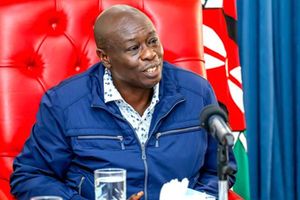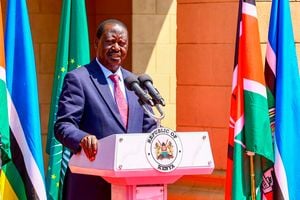The folly of Gachagua's 'one man, one shilling' campaign

Deputy President Rigathi Gachagua
What you need to know:
- The role of the Deputy President is to assist in national governance.
- Prioritising regional interests undermines this national duty.
The Deputy President of Kenya, Rigathi Gachagua, positioning himself primarily as a leader for the Mount Kenya region and championing the “one man, one shilling, one vote” policy, presents significant risks to national unity and development.
This approach risks marginalising less populated but equally needy regions, eroding the sense of national cohesion, and potentially increasing regionalism or tribalism.
Such a focus on population as the sole criterion for resource distribution neglects the diverse needs of Kenya’s various regions, leading to skewed development where more developed or populous regions could receive disproportionate resources, exacerbating existing inequalities.
The role of the Deputy President is to assist in national governance, not to serve as a regional representative.
Prioritising regional interests undermines this national duty, setting a precedent that could lead to further division.
The position taken by Mr Gachagua has already kickstarted the debate about Kenya having 8-9 deputy presidents to champion their regional interests alongside the DP.
Maybe that is what we should do, but what would that mean for our country if that were to be considered?
The idea of having multiple deputy presidents or regional champions could create a competitive and fragmented governance structure, leading to inefficiencies, increased bureaucracy, and slowing down decision-making processes.
This approach could undermine comprehensive national development strategies, replacing them with piecemeal efforts that fail to address broader issues like infrastructure, healthcare, and education uniformly across the country.
Maintaining national unity
Moreover, the perception of bias and inequality in resource distribution can lead to political instability, fuel discontent, and deter investment, slowing economic growth.
While advocating for one’s region can be part of a leader’s role at the local level from a leader in such office, it means role confusion that requires mitigation by his boss because the utterances of Gachagua present significant risks.
A balanced approach that ensures fair representation and resource allocation while maintaining national unity and cohesive development is crucial for overall progress and stability.
The Mt Kenya Region is well-represented in the current government, with over nine cabinet secretaries, including the Attorney General, more than that number of permanent secretaries, the Deputy President, numerous CEOs of parastatals, and twice that number serving as ambassadors and deputy ambassadors in foreign missions.
Given this level of representation, it raises the question: what more does the region need to feel recognised by the Kenya Kwanza Government?
It is unproductive for the region to seem ungrateful and exclude other Kenyan communities from their prosperity.
Furthermore, the population figures from the previous census under President Uhuru Kenyatta do not necessarily confer an absolute advantage to all counties in the Central region.
The proposed “one man, one shilling, one vote” policy may not be beneficial to Mt Kenya as expected. Consider the following census results:
1. Tharaka Nithi - 393,177
2. Embu - 680,599
3. Nyandarua - 638,289
4. Nyeri - 759,163
5. Kirinyaga - 610,411
6. Laikipia - 518,560
7. Kiambu - 2,417,735
8. Murang'a - 1,056,640
9. Meru - 1,545,714
Mere function of population
With six of the nine counties having relatively lower population figures, Gachagua’s proposal appears as a desperate bid to unify support using unanalysed data.
It would be prudent for him to conduct a thorough re-evaluation. A deeper analysis might reveal that their rallying slogan is misleading and potentially harmful, undermining Gachagua’s attempt to position himself as a leader based on the principle of “one man, one shilling, one vote.”
A simulation of his proposal to avoid potential pitfalls and embarrassing outcomes is welcome.
The “one man, one shilling, one vote” policy advocated by some leaders from the Mount Kenya region in Kenya is a proposition that aims to allocate nationally raised revenue based purely on population numbers.
The approach, while seemingly equitable in its simplicity, fails to account for the multidimensional nature of development and the unique challenges faced by different regions in Kenya.
It overlooks critical factors such as land mass, the state of underdevelopment, and the poverty index, which are essential for a fair and balanced approach to national resource allocation.
This policy oversimplifies the complex issue of resource allocation by reducing it to a mere function of population. While population is undoubtedly a crucial factor in determining the needs of an area, it is not the sole indicator of development needs.
Large areas with small populations, such as those in many ASAL (Arid and Semi-Arid Lands) regions, might be underrepresented and underfunded if population were the only criterion used.
These regions often require more significant investment in infrastructure to achieve the same level of service accessibility found in more densely populated areas.
For instance, the cost of providing healthcare, education, and road infrastructure in a vast county like Turkana is considerably higher per capita than in a smaller but more populous county like Kiambu.
By ignoring these aspects, the “one man, one shilling, one vote” approach risks perpetuating the historical marginalisation in disadvantaged regions.
Provide equitable opportunities
Relying solely on population metrics ignores the historical context of marginalisation and underdevelopment that certain areas have faced.
Many regions in Kenya, particularly those in the northern parts, have been neglected due to policies favouring high-potential agricultural areas from colonial times.
These regions are geographically bigger and less populous and suffer from decades of underinvestment, which cannot be corrected merely by equal per capita revenue allocation.
Policies should consider the poverty index and specific developmental needs to uplift these areas. For example, areas with high poverty levels and low human development indices require more targeted interventions to elevate their standard of living and provide equitable opportunities for growth and development.
The policy risks further entrenching regional disparities and fomenting social and political tensions.
Kenya’s diverse demographics and geography mean that a one-size-fits-all approach to revenue sharing could exacerbate feelings of exclusion and inequality.
This could undermine national cohesion and stability, which are crucial for the country’s development.
Using a multi-variable formula that includes land mass, poverty indices, and developmental needs alongside population ensures a more balanced and inclusive approach to resource distribution.
This would promote a sense of fairness and inclusion, reducing the potential for conflict and enhancing national unity.
While the “one man, one shilling, one vote” policy proposed by some Mount Kenya leaders may offer a straightforward solution to revenue sharing, it fails to address the complex realities of other diverse regions.
A more holistic approach incorporating various critical factors - beyond just population - is essential to ensure that all Kenyans have fair access to the resources and opportunities needed to thrive regardless of where they live.
Manipulate resource distribution
Such an approach would better reflect the spirit of equity and justice enshrined in Kenya’s Constitution and would contribute to the balanced development of the nation.
The controversies surrounding Kenya’s census results in the Arid and Semi-Arid Lands (ASAL) regions highlight the intricate interplay between demographics, politics, and resource allocation.
The national census, essential for planning and resource distribution, has often been marred by disputes, particularly in ASAL counties such as Turkana, Isiolo, Mandera, Garissa, Wajir, and Marsabit.
These disputes primarily focus on deliberate actions by the centre to doctor census results to manipulate and influence resource distribution and political representation.
During British colonial rule, the ASAL regions were neglected because they were deemed unproductive for agriculture, the main economic activity.
This was carried further by the Jomo Kenyatta government, which came up with a policy paper that further institutionalised marginalisation through Sessional Paper Number 10 of 1965.
The policy explicitly held that areas deemed unproductive for agriculture should not be invested in by the government.
This further aided the colonial government’s policies that restricted the movement of pastoral communities and allocated fertile lands to European settlers, pushing ASAL communities into less fertile areas.
After independence in 1963, the marginalisation continued due to centralised governance and development policies favouring high-potential agricultural areas.
Development policies and resource allocation favoured agriculturally productive regions, leaving ASALs underdeveloped.
The ASALs, which make up about 80 per cent of Kenya’s land area and are home to approximately 30 per cent of the population, received little investment. This led to poor infrastructure, a lack of public services, and limited economic opportunities.
Sharing of national resources
The 2010 Constitution introduced several measures to address historical injustices and marginalisation of various regions, including the ASALs.
One of the most significant changes was the introduction of a devolved system of government, creating 47 county governments.
Devolution aimed to bring services closer to the people, ensure equitable sharing of national and local resources and give marginalised areas more direct control over their development.
Counties, many of which include ASAL regions, now have their governments and can allocate resources to areas such as health, agriculture, and local infrastructure.
Article 204 of the Constitution established the Equalization Fund, which required 0.5 per cent of revenues to be set aside for marginalised areas to provide basic services to bring them up to the level of other parts of the country.
The fund targets infrastructure, education, health, and water services in the most disadvantaged areas, many of which are in the ASALs.
However, since the advent of devolution in Kenya, the implementation of the Equalization Fund has faced various challenges.
Even where the Senate has made some efforts to give it traction, the National Treasury has deliberately not released the appropriated money to the fund for the financial years 2022-2023 and 2023-2024, in violation of the law.
In other jurisdictions, the Cabinet Secretary for Finance and Economic Planning would be impeached for violating the law, but in Kenya, and particularly if it relates to the ASALs, the centre does not care.
The implementation of the Equalization Fund has failed.
The census results in the ASAL regions are deliberately underreported to skew resource allocation and limit political representation.
Negative population growth
The integrity of census data has been a significant issue. The 2009 census results were particularly contentious, with several ASAL counties alleging inflation and undercounting.
The government’s released figures led to disputes among leaders from Northern Kenya, resulting in legal challenges and a prolonged debate over the accuracy. This dispute ultimately ended in court, with a ruling in favour of the ASAL region.
Similarly, the 2019 census results were accused of being doctored, showing negative population growth in some Northern Kenya areas despite higher fertility rates than other regions. These results were also disputed and led to legal action.
The controversy around the implementation of the Equalization Fund forced President Uhuru Kenyatta to implore the Commission of Revenue Allocation to amend the beneficiary areas from the original 14 counties to 1,442 beneficiary areas to include what they termed as pockets of marginalised areas from 33 counties.
This, in effect, led to a situation where marginalisation was equated to poverty and vice versa instead of understanding it as poverty and underdevelopment resulting from deliberate resource denial by successive governments since independence.
The implementation of the Equalization Fund has pretty much stalled, and the government doesn’t seem to care.
What’s even worse is all 47 counties claim to be marginalised and expect to benefit from the stalled fund.
The Bill seeking to extend the sunset clause by an extra 10 years due to the fund's failed implementation as envisaged in the constitution was passed more than six months ago and is in the National Assembly.
Critics might argue that the figures from the last census under President Uhuru’s administration do not offer any decisive advantage to all counties in the central region, especially considering the “one man, one shilling, one vote” initiative proposed by Gachagua.
Perhaps Mt Kenya leaders need to be contented with their blessings rather than constant complaints because the other 43 tribes are asking themselves - why is the Mt Kenya region getting over 30 per cent of all presidential appointments, 23 per cent of all public service employment, and over 30 per cent of the national government allocation for development when their population in Kenya is only 17 per cent of the national population?




